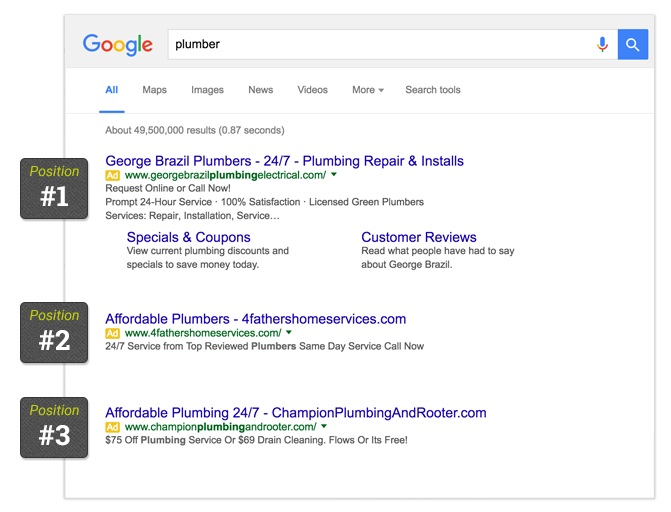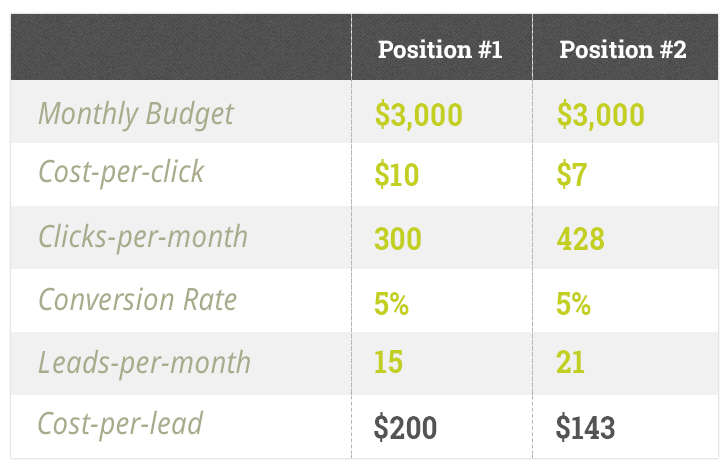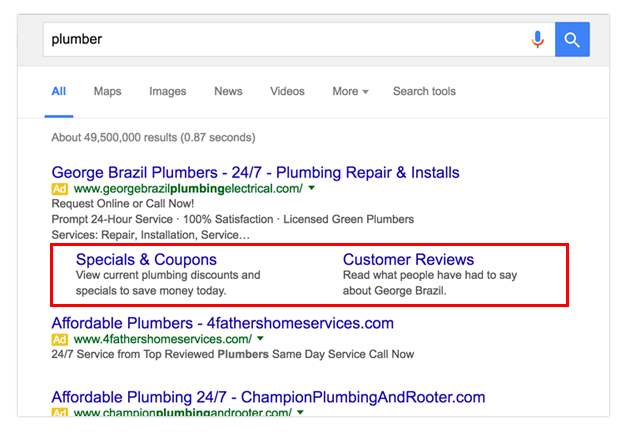You know it’s important for your website to rank #1 on Google.
Everyone knows that’s where you get the most clicks, but is it the most profitable position when it comes to pay-per-click?
The goal of SEO is to rank as high on the search results as possible. The goal of pay-per click (PPC), on the other hand, is to attract the most qualified traffic for the least amount of money.
With PPC, getting the top ad position is easy. But getting the best return on investment? That’s the real challenge.
Here’s a little secret: Sometimes you can actually get a better return by intentionally avoiding first position in search results.
“You don’t need to be #1 on Google. Here’s why.”
Let’s dig in.
Ad positions #2 and #3 can produce higher ROI
Whenever you do a Google search, a set of ads appears based on the keyword you used. Up to four ads show at the top of the page, but usually you’ll see only three.
While the top ad position on Google tends to garner the most clicks, it’s also the most expensive. For many campaigns, aiming for a position further down the page is still going to generate the traffic you want at a lower cost.
For example, let’s say your ad is showing in position 1 and you have a monthly budget of $3,000. If your cost-per-click in the top position is $10, you’ll get 300 clicks each month. Once those users land on your website, 5% of them convert to leads. That means you’re getting 15 leads a month, at a cost-per-lead of $200.
In position 2 or 3, the cost-per-click will be a bit lower. You might pay $7 per click as opposed to $10, so for the same budget of $3,000, you’ll get about 428 clicks each month. With the same 5% conversion rate you could get 21 leads, at a cost-per-lead of $143.
That’s 6 more leads for the same budget.
Elements that influence ad position on Google
Adjusting your ad position to the more profitable #2 or #3 spot isn’t always as simple as lowering your bid.
There are several other elements that influence each ad’s Ad Rank. This is a score that Google calculates based on your Quality Score, any alterations made to the ad (such as extensions), and your bid. The ad with the highest Ad Rank will show up first, and the next highest will follow.
Quality Score
According to Google, your Quality Score is impacted by three components:
- Expected click-through rate – How likely is it that someone who searched for a particular keyword will click on your ad?
- Relevance – How closely does your ad align with what the user is searching for? Then, does your landing page relate to the topic at hand?
- Landing page experience – Is your landing page mobile-friendly? Does it offer clear and complete information?
Extensions
Ad extensions are fantastic tools for increasing your click-through rate and conversions. You can add things like extra page links, a phone number (with call tracking!), and an address to help searchers find where you’re located.
The extensions will not show up in every search, but their presence is factored into your overall Ad Rank.
Bid
If you’ve created the best ad possible, you’ll be able to control your ad position by adjusting your bid. To put it simply, when you decrease the bid, your listing will likely move down the page. When you increase the bid, the listing will likely move up.
Getting the most bang for your buck
Ranking in position 2 or 3 is a delicate game.
If you play it right, you have the potential to increase your ROI by getting the same amount of traffic for a lower cost.
Although it’s not all about bidding, playing with different bids is a fast way to test out the price points for each ad position and see how much you could save by showing ads in position 2 or 3.

- To start, look in your account to find top position bid that pushes your ad to the number 1 spot.
- Once you’ve found how much it costs to be in the first ad position, scale back slowly. As you lower your bid, your average position will increase, meaning your ad will move further down the page.
Keep in mind that the bidding process is an auction, with tons of companies vying to rank for the same keyword. Increasing or decreasing your bid might not have a huge impact on your ad position if your competitors are actively changing their campaigns as well. Keep testing to figure out which changes move the needle.
- Once you find the bid that consistently shows your ad around position 2 or 3, you can move into maintenance mode. Things change weekly – even daily – in AdWords, so you’ll want to keep an eye on your campaign and make any changes needed to maintain a competitive Quality Score and bid.
Let us find your ad’s best position on Google
Building a successful AdWords campaign requires time and expertise. Plus, the constant adjustments needed to produce the best ROI can be overwhelming.
But don’t worry. At ParaCore, our team of specialists will craft the perfect PPC strategy to win leads at the right cost. And you’ll have complete visibility into how every action we take is helping meet your goals. Sign up for a free AdWords audit or info session today.
Related Posts
- What Is The Difference Between PPC and SEM?
- PC Audit Handbook: How to Analyze Your PPC Campaigns
- The Best PPC Tools of 2022, As Told by PPC Experts
- Beginner’s Guide to UTM Tags & Tracking
- Generate Leads with Facebook Lead Ads
- Cost-per-click vs. cost-per-acquisition: Are you tracking the right PPC metrics?
- How Does Pay Per Click Work?
- Benefits of PPC
- Why Should I Invest in PPC?
- What is Google PPC Advertising?
- Facebook Retargeting Strategy
- Introduction to ManyChat
- Case Study: Return on Ad Spend Optimization
- 🎁🎄 Holiday Ad Spend Strategy
- Should You Be Running Branded Ads?
- SEO vs SEM
- CTAs for YouTube Ads
- Case Study: 258% Increase in Conversions
- Traffic Campaign Strategy
- No Captions on Facebook Ads or YouTube? You’re Killing Performance
- LinkedIn InMail Website Re-targeting







